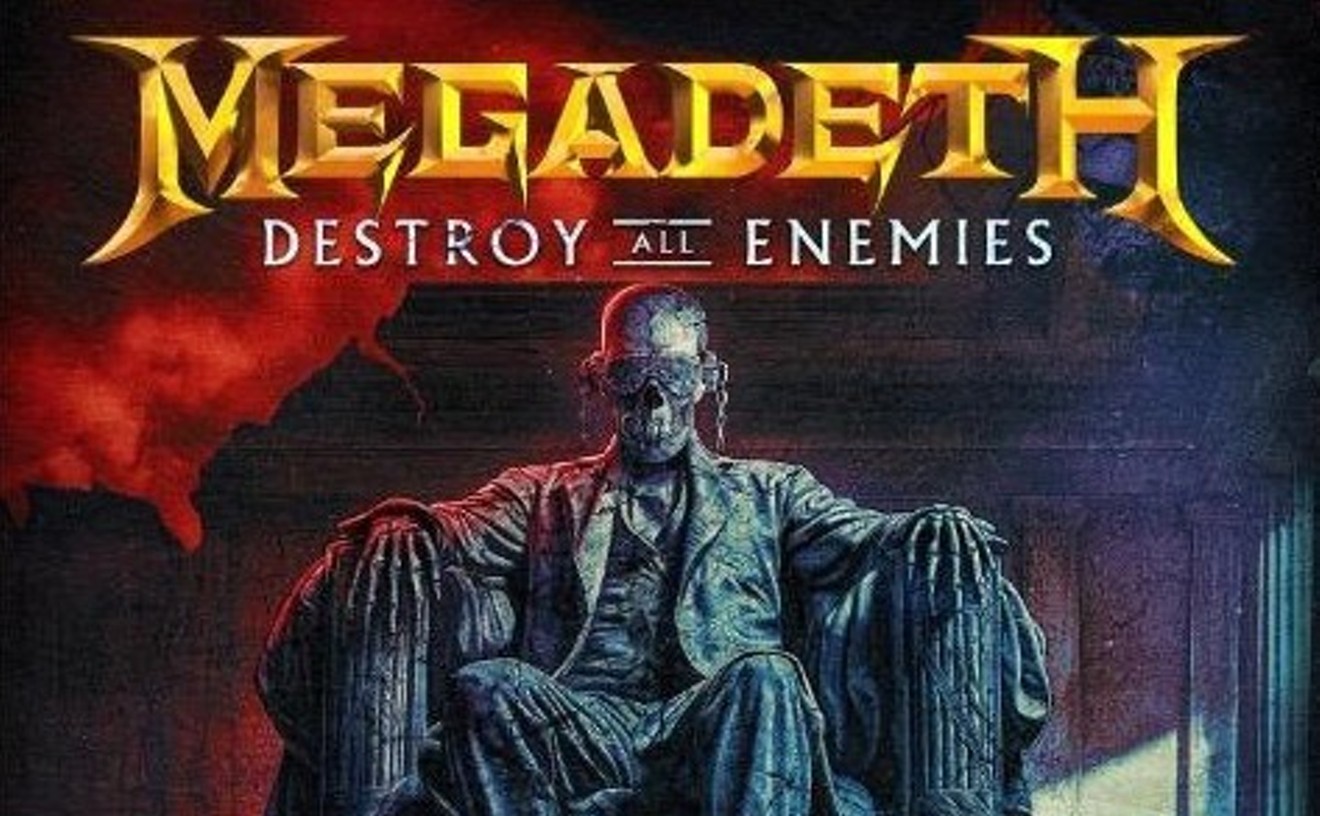In Britain it's shaken up music, fashion and virtually the whole of U.K. youth culture. In Italy, its synthesis of classic funk samples and trippy techno-beats has been mesmerizing discophiles for almost a year. In cities like New York and L.A. it's considered to be the hippest thing to happen to dance music since hip-hop.
This phenomenon, which magazines from Spin to Life have recently dubbed the year's clubland sensation, is called Acid House, and it's making its mark in danceterias nearly everywhere in the country. But not in Phoenix.
Why are we missing out on Acid House? For that matter, why has most of the decade's alternative dance music--hip-hop, house (the Chicago-style sound not to be confused with Britain's Acid House) and go-go--gotten the cold shoulder from Phoenix clubs? For answers, let's take a tour through the Valley's ostensibly progressive niteries.
Phoenix's Out of Water has the distinction of being this area's only bastion of cutting-edge dance music. Oh sure, MAXS 919 in Tempe hosts Six Feet Under on Wednesdays, and the cramped lower level of Tempe's UM Club features a progressive playlist. But Out of Water is the only desert dance hall dedicated exclusively to alternative music. This hip-music haven even devotes one of its two dance floors almost entirely to hip-hop and house. Trouble is, this floor usually boasts only a handful of hard-core house fans, while the club's other boogie space, which sticks to more conventional industrial dance and Eurodisco, is often packed.
On a recent evening, Out of Water deejays fail to fill up either floor, despite spins of sure-bet collegiate crowd pleasers like New Order. A giant fluorescent Joker looms menacingly over the dance floor from a Batman-Gotham City mural that covers one wall. But it's a dead night at this graffiti-covered, black-light dance pad, which usually boasts a rowdy frat-boy/sorority-sister clientele. The stillness is broken momentarily by a couple of skinheads who stomp around the floor to some disco number in their steel-toed Doc Martens.
Despite their mock-skanking, the skins, Thorsten Kampe, 22, and Henning Lucht, 21, aren't exactly grooving on the bill o' fare at the Watering hole. However, the West German-born punks, who are going to school in the Valley, aren't much put out by Phoenix's lack of Acid House venues. "There's too much house music here anyway," groans Kampe in a thick Teutonic accent. "We can't stand it. It's too boring after hearing it for more than half an hour. It's too discolike."
Begging to differ is Randall Goodwin, 23, an inveterate Valley club hound. Goodwin, who deejayed and did promotions for New York niteries before moving to Phoenix, considers Acid House to be the last, great hope of the local club circuit. "Phoenix needs something different," says the mousse-maned Goodwin, who resembles a less-prettified Jon Bon Jovi. "Acid House is kind of changing [the club scene] because it brings in that kind of hard-core sound. Lots of other music is just too generic."
The weekly "alternative" nights of other Valley clubs have had little to offer Acid House addicts like Goodwin. The defunct Premiere nightspot in Tempe stuck to a routine Depeche Mode-Cure-New Order playlist during its progressive Sundays a couple of years back. A more interesting happening was the short-lived Tone Deaf on Monday nights at the Sun Club last summer. The Ohio Players' "Fire" segued into Fuzzbox's "Jackie" during Tone Deaf's way-hip music sets, which usually managed to include a few propulsive house cuts as well.
Six Feet Under at MAXS (formerly Utopia) has enjoyed more longevity than most other underground music nights, even though its format has often been alternative in name only. During the past year, the club's playlist has generally ignored house, hip-hop and go-go in favor of circa-1982 new-wave relics like Romeo Void's "Never Say Never" and the Cure's "Let's Go to Bed." The nightspot has yet to build a faithful following, which could be blamed on Six Feet's tendency to give deejays the boot before they've had a chance to gauge the tastes of clubgoers.
On a recent evening, there aren't any protests about new deejay Chris Flores' mix, which incorporates a few Acid House numbers. Still, clubgoers aren't showing much enthusiasm either, even when Flores tries to shock some life out of them with a campier cut like Donna Summer's "Bad Girls." Some in the crowd seem less interested in shaking their groove thang than in studying themselves on the multiple TV screens, which provide near-continuous coverage of the dance floor.
HOUSE MUSIC BEGAN in Chicago several years back, a deejay's concoction of samples from old soul records blended with repetitive bass and keyboard patterns.
Then, early last year, London deejays began corrupting this formula by increasing the random sampled noise to create a sound that was less hard-edged and more hypnotic. Many claim that the movement derives its name from "Acid Trax" by Phuture, although Acid House could have just as easily been christened by clubbers who found that the music's inherent trippiness was enhanced by hallucinogens.
Oblique references to stimulants are found in many singles, such as the "Let me take you higher" chorus from "Superfly Guy." That track also reflects Acid House's fascination with the sleazy side of Seventies culture. "Superfly Guy" and another of S-Express' tracks, "Pimps, Pushers, and Prostitutes," feature the same kind of heroic portraits of superstud hustlers as Seventies black-exploitation flicks.
The narratives of bad-ass dealers and coked-up whores on some A.H. tracks are wed to samples from old Commodores or Taste of Honey records. The result often sounds like a frightening mutation of Seventies disco, which is why some listeners are turned off. "A lot of it is just old disco redone," says Billy Long, a deejay at one of L.A.'s premier A.H. hangouts, Catch One. "Sometimes the bass is brought up and there are a few other changes, but the overall sound is the same. But I'm not talking about all the singles. Some are really creative."
It's true enough that Acid House has produced a handful of solid singles like Bomb the Bass' "Beat Dis." Still, an offshoot of A.H. that emerged recently called Deep House, with its emphasis on soulful vocals, may prove to be more interesting. Another possible successor to A.H. is Garage House, which is tougher, less discofied music that takes its moniker from the one-time Greenwich Village nightspot Paradise Garage.
This explosion of club sounds has meant that in cities like New York and London, discos have actually become places for dancing--not just for fashion parades. Some U.K. clubbers even conform to a scruffy A.H. uniform: frayed Levi's, a tee shirt and a bandanna or shmatte wrapped around the head to soak up sweat from all the violent frugging. The trendies also sometimes opt for a Seventies smiley-face pin, the emblem of Acid House. Forget about rock couture; A.H. has made dressing-down fashionable.
SO WHO'S TO BLAME for the Valley's dearth of underground dance music? Unadventurous deejays? Uncool clubbers? Well, if you ask the honchos at some local niteries, they tell you that they couldn't be the culprits behind the hicksville dance scene. They claim to have little control over music formats. Vinnie Guifre, owner-manager of Six Feet Under, claims that it's the deejays and the clubbers who are the final dictators of his playlist.
Local deejays also plead innocent, saying that when they experiment with a more alternative mix, all they get is an empty dance floor. "People are always saying Phoenix is never going to go anywhere, yet when you play new music, they don't dance!" complains Jackie Selby, a KUPD-FM radio jock who's served two stints behind the turntables at Six Feet Under.
That criticism of unhip clubgoers is echoed by Marilyn Whitelaw, who handles deejay chores at UM's boogie basement. When she took a chance and began spinning Acid House tracks late last summer, audiences were markedly unimpressed. "It's the same with any new music," laments Whitelaw. "If they haven't heard it on the radio, then they can't identify it, and they don't want to have anything to do with it."
There's no disputing the correlation between Phoenix's relative lack of underground dance dens and the absence of alternative radio. Considering that the city is bereft of black or progressive stations, listeners aren't exposed to the new Acid House rhythms from London or the current go-go cuts from Washington, D.C.
Even if local radio stations were satisfying hip-hop- and house-hungry listeners, it still would be nearly impossible to buy the stuff. Many Phoenix deejays complain that unsupportive labels are thwarting bigtime success for Acid House by making it difficult for people to get their hands on the music. "There's no service or distributor, so how the hell are we supposed to get it?" bitches Selby. Flores has sources in San Francisco and Chicago, while Whitelaw smuggles in hits of hard-to-find Acid House from Minneapolis.
The record companies seem uncertain how to market the new sounds. Acid House is basically a deejay's dance product, and labels don't know how to hustle a band that has an anonymous deejay at the forefront instead of a star singer.
WHEN IT COMES to trends like Acid House, Phoenix is about as with it as Bullhead City. Still, the news from clubland isn't all bad. The Valley's dance scene got a sorely needed kick in the butt last spring with the run of Big Payback, an L.A.-style "floating" club. This very underground (i.e., unlicensed) danceteria changed venues as often as every week during its two-month existence. This was an exciting concept in clubbing not only because of its downtown locations (abandoned warehouses usually) and its interesting mix of partyers, but also because of its music, which on one of its two dance floors was nonstop house and hip-hop.
These traveling clubs go over big in Los Angeles, where the local L.A.P.D. is too busy battling crack to bust an illegal nitery. But here, when the Payback began attracting enough clubbers to cause a dip in the business of rival nightspots, someone started snitching to cops that underagers were frequenting the post-punk speakeasy. The ensuing weekly hassles by the police led to the demise of this swinging alternative-dance space.
The Payback was proof that there are Valley club crawlers willing to support progressive music. And lately other dance halls around town seem to be wising up to this fact. While most clubs still show little daring in their pre-1 a.m. playlist, deejays have recently been cutting loose during after-hours. Flores claims the after-1 a.m. crowds, particularly the underagers, seem to be getting hip to the electronic house beat. "Three months ago, I wasn't able to play a couple of Acid House songs without throwing in a New Order song to keep the crowd going," he says. "Now I can get away with playing sets of it during after-hours."
Acid House may be as fleeting a clubland trend as the hustle. It certainly isn't going to have the same impact as hip-hop, no matter what the fad-happy U.K. music rags say. Still, A.H. is the most exciting thing to happen to dance music in years, and it's time local clubs got hip to it--before last call.
Maybe the malaise of the Phoenix club scene can't just be blamed on backward deejays or unreceptive crowds. There are those like Selby who feel the cause of the affliction lies a little deeper. "We keep telling ourselves here in town that we're behind, and we're always going to be behind," she figures. "It's just a mentality that we need to get out from under. There are some of us who don't believe that. There are some of us who believe that if we stop telling ourselves that we're ugly, maybe we won't be anymore.









